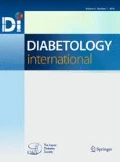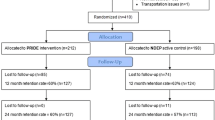Abstract
Objective
Whereas many people at high risk of developing type 2 diabetes are detected through screening in a Japanese healthcare setting, they do not necessarily seek primary care for diagnosis and treatment in the early stages of the disease. This study aimed to identify the most effective health communication method for the diabetes screening report to encourage primary care consultation.
Methods
This facility-based cohort study involved 1,128 Japanese participants identified from the routine diabetes screening database from 2003 to 2009 who were considered to be at high risk of type 2 diabetes. Multiple logistic regression analyses were performed to estimate the relative effectiveness of the health communication method—a letter or an interview—regarding the likelihood of seeking primary care. The study controlled for sex, age, family history of diabetes, perceived symptoms, recommendation for diabetes care, undergoing treatment for other diseases, detection of comorbidity, request for referral to a specialist, and counseling by a public health nurse or dietician after screening.
Results
The proportion of participants who sought primary care after screening was 7 %. Those who received feedback on diabetes screening via physician interview were more likely to seek primary care consultation (odds ratio 2.6, 95 % confidence interval 1.2–5.6).
Conclusion
Health communication in the form of an interview with a physician after diabetes screening may encourage people at high risk of type 2 diabetes to seek primary care, yet very few seek primary care in the early stage of the disease. Therefore, more effective communication methods are needed.

Similar content being viewed by others
References
Ministry of Health, Labor and Welfare. Outline of results from 2007 National health and nutrition survey. http://www.mhlw.go.jp/english/wp/wp-hw3/dl/2-064_065.pdf (2012). Accessed 15 Oct 2012.
Ministry of Health, Labor and Welfare. Health statistics in Japan 2007. http://www.mhlw.go.jp/english/database/db-hss/dl/hs2007a.pdf (2012). Accessed 15 Oct 2012.
Ministry of Health, Labor and Welfare. Measures for National Health Promotion. http://www.mhlw.go.jp/english/wp/wp-hw2/part2/p3_0024.pdf (2012). Accessed 15 Oct 2012.
Fukuda H, Shinsho F. Accuracy of health examination results self-reported by Japanese participants. J Public Health (Oxf). 2007;29:316–20.
Ministry of Health, Labor and Welfare. Annual Health, Labor and Welfare Report 2007–2008. http://www.mhlw.go.jp/english/wp/wp-hw2/part2/p2c1s3.pdf (2012). Accessed 15 Oct 2012.
Sakane N, Sato J, Tsushita K, Tsujii S, Kotani K, Tsuzaki K, et al. Japan diabetes prevention program (JDPP) research group. Prevention of type 2 diabetes in a primary healthcare setting: three-year results of lifestyle intervention in Japanese subjects with impaired glucose tolerance. BMC Public Health. 2011;11(1):40.
Tsuda K, Tsutsumi A, Kawakami N. Work-related factors associated with visiting a doctor for a medical diagnosis following a worksite screening for diabetes mellitus in Japanese male employees. J Occup Health. 2004;46:374–81.
Oishi M. JDNR group: application of a computerized information system for diabetic network research in Japan. In: Aoki N, Akazawa Y, Laporte R, editors. e-Health for diabetes in the Western Pacific: proceedings of the 1st International Conference on the Western Pacific diabetes information network (WPDIN) held in Kyoto on 14 November 1999. Amsterdam: Elsevier; 2000. p. 77–83.
Arnold E. Developing therapeutic communication skills in the nurse-client relationship. In: Interpersonal relationships professional communication skills for nurses. 5th ed. St. Louis: Saunders Elsevier; 2003. p. 199-228.
Irie M, Nagata S, Miyata M, Ikeda M, Hirayama S. Psychosocial evaluation on the correct recollection of periodic medical checkups of workers. 2. Long-term change in the recalled results of medical checkups. Sangyo Eiseigaku Zasshi. 1998;40(3):75–84 (in Japanese).
Adachi Y, Matsumoto K, Konishi K, Yokota T, Irisawa Y, Ikuta J, et al. Referral compliance improved by a letter of introduction to a specific physician following mass screening. Nihon Kosyu Eisei Zasshi. 1988;36(7):413–9 (in Japanese).
Alberti ZP, Shaw J. International diabetes federation: a consensus on type 2 diabetes prevention. Diabet Med. 2007;24(5):451–63.
Japan Human Dry Dock Association. A small committee report for the guideline in regard to determination of health screening tests results. Off J Jpn Soc Human Dry Dock. 2002;17(2):14–30 (in Japanese).
The Committee of the Japan Diabetes Society on the diagnostic criteria of diabetes mellitus, Kuzuya T, Nakagawa S, Satoh J, Kanazawa Y, Iwamoto Y, Kobayashi M, et al. Report of the Committee on the classification and diagnostic criteria of diabetes mellitus. Diabetes Res Clin Pract. 2002;55(1):65–85.
The Committee of the Japan Diabetes Society on the diagnostic criteria of diabetes mellitus, Seino Y, Nanjo K, Tajima N, Kadowaki T, Kashiwagi A, Araki E, et al. Report of the Committee on the classification and diagnostic criteria of diabetes mellitus. Diabetol Int. 2010;1:2–20.
Shimizu M, Izumi Y, Takahashi M, Ogushi Y. Analysis of factors which affects movement after health examinations. In: 17th JCMI. http://www.med.shimane-u.ac.jp/jcmi97/paper/S54.htm (1997). Accessed 15 Oct 2012 (in Japanese)
Yamaguchi N, Okubo T, Yamamura J, Takahashi K, Nakamura R, Funatani F. A prospective study of access to medical services following a community-based screening program. Nihon Koshu Eisei Zasshi. 1990;37(4):281–8 (in Japanese).
Kashiwagi A, Kasuga M, Araki E, Oka Y, Hanafusa T, Ito H, Committee on the Standardization of Diabetes Mellitus-Related Laboratory Testing of Japan Diabetes Society, et al. International clinical harmonization of glycated hemoglobin in Japan: from Japan diabetes Society to national glycohemoglobin standardization program VALUES. Diabetol Int. 2012;3(1):8–10.
Rahman M, Simmons RK, Hennings SH, Wareham NJ, Griffin SJ. Effect of screening for type 2 diabetes on population-level self-related health outcomes and measures of cardiovascular risk: 13-year follow-up of the Ely cohort. Diabet Med. 2012;29(7):886–92.
Rahman M, Simmons RK, Hennings SH, Wareham NJ, Griffin S. How much does screening bring forward the diagnosis of type 2 diabetes and reduce complications? Twelve year follow-up of the Ely cohort. Diabetologia. 2012;55(6):1651–9.
Waugh N, Scotland G, McNamee P, Gillett M, Brennan A, Goyder E, et al. Screening for type 2 diabetes: literature review and economic modeling. Health Technol Assess 2007; 11(17).
International diabetes federation. Global guideline for type 2 diabetes. http://www.idf.org/global-guideline-type-2-diabetes-2012 (2013). Accessed 14 Feb 2013.
Ministry of Health, Labor and Welfare. Summary report of comprehensive survey of living conditions 2010. http://www.mhlw.go.jp/english/database/db-hss/dl/report_gaikyo_2010.pdf (2010). Accessed 26 Aug 2013.
Acknowledgments
We are grateful to Dr. Katsuya Yamazaki of Kawai Clinic for his comments on an earlier draft.
Conflict of interest
None.
Author information
Authors and Affiliations
Corresponding author
About this article
Cite this article
Ueki, R., Ichikawa, M., Hiranuma, Y. et al. Health communication method and primary care seeking after screening for early type 2 diabetes in a Japanese healthcare setting. Diabetol Int 5, 122–128 (2014). https://doi.org/10.1007/s13340-013-0143-x
Received:
Accepted:
Published:
Issue Date:
DOI: https://doi.org/10.1007/s13340-013-0143-x




